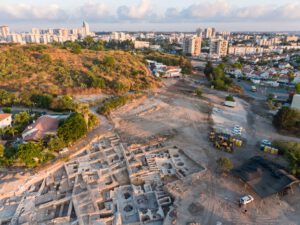 Israeli archeologists are nearly bald from puzzled head-scratching. First was the discovery of a sunken mound of rubble beneath the Sea of Galilee, now comes the mysterious unearthing of an ancient Egyptian sphinx in northern Israel. Make that “parts” of an ancient Sphinx: so far, only segments of its face and feet have been recovered, but archaeologists expect to find more as the dig continues.
Israeli archeologists are nearly bald from puzzled head-scratching. First was the discovery of a sunken mound of rubble beneath the Sea of Galilee, now comes the mysterious unearthing of an ancient Egyptian sphinx in northern Israel. Make that “parts” of an ancient Sphinx: so far, only segments of its face and feet have been recovered, but archaeologists expect to find more as the dig continues.
The remarkable and mysterious find happened last August at the Tel Hazor dig site in Galilee, kicking off speculation as to how the stone-carved statue traveled so far from its origins. It may be evidence of ancient war booty, or perhaps the mythical creature was gifted by Egypt. It’s the first time an Egyptian statue has been found in the ancient Levant region, now modern-day Israel, Lebanon and Syria.
Archeologists worked for nearly a year to restore the statue’s granite paws and forearms, in the process exposing hieroglyphic inscriptions that reveal the sphinx was dedicated to Egyptian ruler Mycerinus. He ruled circa 2,500 BC and built the smallest of Giza’s three great pyramids.
Amnon Ben-Tor, archaeology professor at Hebrew University, suggests the sphinx was brought to Tel Hazor 3,000 years ago. Ben-Tor told AFP, “That it arrived in the days of Mycerinus himself is unlikely, since there were absolutely no relations between Egypt and this part of the world then.”
“Egypt maintained relations with Lebanon, especially via the ancient port of Byblos, to import cedar wood via the Mediterranean, they skipped past today’s northern Israel”, he said. He believes the most likely way the sphinx reached Tel Hazor is as a gift sent by a later Egyptian ruler.
As to the deteriorated state of the statue, Ben-Dor said it was probably deliberately broken by later occupiers at Tel Hazor in an act of defiance to older rule.
Shlomit Blecher, who manages the Selz Foundation Hazor Excavations, was the archaeologist who unearthed the finding in August 2012. The remarkable discovery occurred on “the last hour of the last day of the dig,” she told AFP.
Learn more in this short video clip by Dr. Sharon Zuckerman of Hebrew University’s Department of Archeology:
[youtube]http://youtu.be/AfTXTdhgUhQ[/youtube]
Image of Sphinx on Egyptian Stamp from Shutterstock




If I’m not mistaken, did not the area belong the the Caininnites? and they are cousins to the Egyptians so there probably was a very close relationship back then.
Petrie – The statements in the story are based on the published quotes of professor Amnon Ben-Tor – fair enough to disagree with them. Your rebuttal of his claim that Israel was “skipped” sounds spot-on, but again, that comment is one man’s opinion.
As for using modern place names when referring to ancient civilizations? It’s an absolute necessity to communicate location to a wide audience, not comprised solely of historical or archeological scholars.
There are numerous inaccuracies in this article.
” It’s the first time an Egyptian statue has been found in the ancient Levant region”
It isn’t the first at all. Not even the first Sphinx. An ancient Egyptian sphinx was discovered near Damascus at Qatna a few years ago dating to the reign of Amenhetep (1875–1840 BC).
““Egypt maintained relations with Lebanon, especially via the ancient port of Byblos, to import cedar wood via the Mediterranean, they skipped past today’s northern Israel”, he said. ”
First of all, it’s extremely misleading to use modern names of states to describe ongoings from 4000 years ago.
Secondly, Egypt did not “skip” Israel. Northern Egyptian culture developed as a part of Levantine culture from the Halfan culture to the pre-dynastic Harifian and Merimde cultures. And during the pharaonic period Egypt occupied and controlled the Levant repeatedly and for hundreds of years. During the reigns of Ramses, Seti, Amenhotep, Thuthmosis, and others. So unless the the professor is talking about the specific decade from which the sphinx dates, I find it hard to believe that Egypt had no relations with an imaginary arbitrary modern border, or chose to magically skip modern day Israel and just conquer everything around it.